 I started my hunting “career,” for want of a better term, in the early 1960’s with the very first firearm I ever had, a Montgomery Ward’s 20-gauge shotgun. I diligently studied articles in Field & Stream magazine and knew that in order to hunt the squirrels who inhabited my father’s woods I needed shells loaded with #6 shot.
I started my hunting “career,” for want of a better term, in the early 1960’s with the very first firearm I ever had, a Montgomery Ward’s 20-gauge shotgun. I diligently studied articles in Field & Stream magazine and knew that in order to hunt the squirrels who inhabited my father’s woods I needed shells loaded with #6 shot.
Stanfordville, New York in those days was very much a rural farming community. Since a shotgun is a basic tool for farmers there was one in every house and every small general store sold ammunition. There were two such stores in the village two miles from my family’s house, which was not a great distance for a healthy kid to walk, especially when there was such a prize to be had in return for the trip. Now, in 1961 it was perfectly legal for a 14-year-old to buy shotgun shells over the counter with no questions asked. Number 6’s were the most common size, so of course the stores had them in stock. Those shells were made of paper. Paper shotgun shells had been around for nearly a century by the time I started hunting and I didn’t know any other kind existed for some years after that point in my life.
 To make a paper hull a many-layered rolled tube was oiled, sized, waxed, and set into a brass base. This technology had been successfully used since the late 19th Century. The open end of the shell was closed with a “crimp,” of which there were two types. One was the “roll crimp": the open end of the shell had a very thin cardboard disc set over the top of the shot charge. The end of the tube was then turned over to form a smooth rim. This held the disc and the shot beneath it in place. The other type was the “folded” crimp. The open end was formed into six (sometimes eight) pie-wedge-shaped segments which were then compressed to meet in the middle.
To make a paper hull a many-layered rolled tube was oiled, sized, waxed, and set into a brass base. This technology had been successfully used since the late 19th Century. The open end of the shell was closed with a “crimp,” of which there were two types. One was the “roll crimp": the open end of the shell had a very thin cardboard disc set over the top of the shot charge. The end of the tube was then turned over to form a smooth rim. This held the disc and the shot beneath it in place. The other type was the “folded” crimp. The open end was formed into six (sometimes eight) pie-wedge-shaped segments which were then compressed to meet in the middle.
There was an on-going debate over which crimp was “better.” Adherents of the folded crimp maintained that the over-shot card would interfere with the shot pattern, leaving large holes through which game might escape. Those who preferred rolled crimps pointed out t hat there was more room in the shell for the powder, over-powder wads, and shot; hence breech pressures were lower. Both crimps were nothing more than marketing and sales points but they generated an argument which could never really be settled. In truth if there’s even a
hat there was more room in the shell for the powder, over-powder wads, and shot; hence breech pressures were lower. Both crimps were nothing more than marketing and sales points but they generated an argument which could never really be settled. In truth if there’s even a 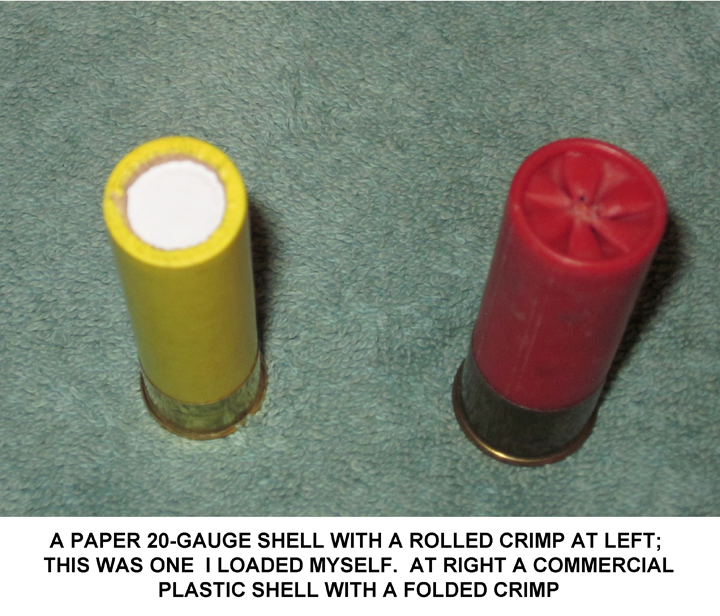 nickel’s worth of difference between them I’d be very surprised.
nickel’s worth of difference between them I’d be very surprised.
Despite decades of successful use paper shells did have some drawbacks. In very wet environments (such as the bottom of a duck boat) they sometimes would swell and refuse to enter the gun’s chamber. They weren’t particularly fragile but they could be damaged by rough handling. Plastics technology had advanced considerably by the early 1960’s: I first find mention of plastic shotgun shells in the 1964 Shooter’s Bible. They aren’t listed in the 1962 edition, so 1963 is probably just about when the first versions hit the market.
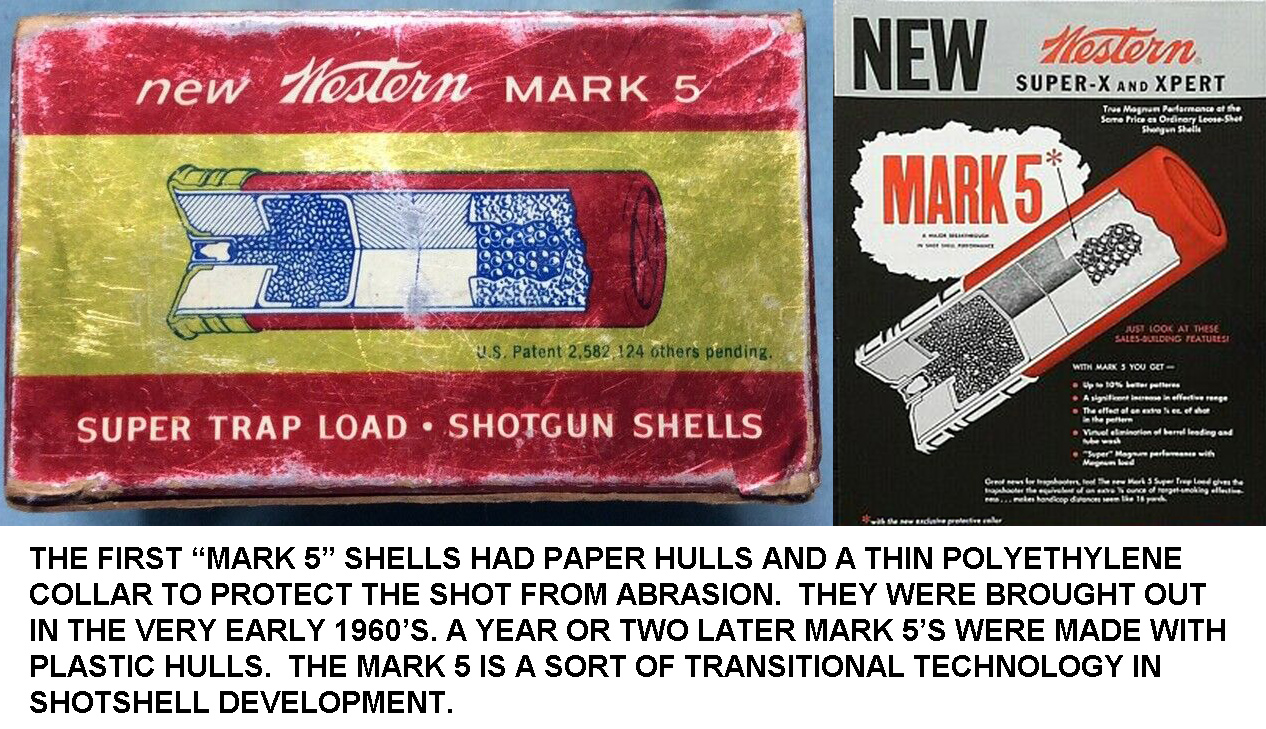
There was a sort of transition period in which paper-hulled shotshells were “improved” by the use of a “shot collar,” around the shot charge to protect it from abrasion as it passed down the barrel. This wasn’t an especially innovative technology but Winchester/Western trumpeted the “Mark 5 ” shotshell as the bee’s knees in its advertising in the very early 1960’s. The original Mark 5 ’s did indeed have paper hulls but these were shortly replaced with plastic hulls so that the originals are something of a collector’s item these days.
 About 1964 or so truly “plastic” shotshells were introduced. The manufacture of plastic shotgun shells is considerably simpler and cheaper than that of paper ones so they represented a real benefit for the manufacturers. Plastic tubes are extruded from a machine, cut to length, inserted into a base, and loaded. The complicated process and specialized machinery required to make paper shells could be dispensed with at considerable cost savings; the final product could be brought to market faster and at a better price.
About 1964 or so truly “plastic” shotshells were introduced. The manufacture of plastic shotgun shells is considerably simpler and cheaper than that of paper ones so they represented a real benefit for the manufacturers. Plastic tubes are extruded from a machine, cut to length, inserted into a base, and loaded. The complicated process and specialized machinery required to make paper shells could be dispensed with at considerable cost savings; the final product could be brought to market faster and at a better price.
Plastic shells have many advantages. First, they’re pretty much completely waterproof. I once washed a hunting jacket with (unknown to me at the time) two plastic hulled shells in a pocket. After a complete wash-and-dry cycle, they were totally unharmed, firing perfectly. No paper shell would have withstood such mistreatment! Plastic shells probably found favor with waterfowl hunters almost as soon as they came out. Plastic shotshells are “slick,” feeding well in autoloading shotguns. They’re very resistant to any sort of mechanical damage.
Needless to say with time further improvements, including one-piece plastic wads and shot cups (the latter replacing the old Mark 5 shot collar entirely) greatly enhanced the performance of modern shotshells compared to older designs. Today paper shells are still made, but there is more or less universal recognition and acceptance of the advantages of plastic ones, especially for hunting.
Yet there are other considerations, some more significant than others. I suspect the principal reason why some of us (especially Geezers like me) prefer paper shells is nostalgia: they’re what we grew up with, what we started with. Most people have at least a moderate degree of yearning for “lost youth,” a feeling which can’t be denied. It plays a part in what we buy (and why we buy it) so the marketeers have to take this into consideration. I will not—I cannot—question the superiority of performance of plastic shells. But if there is one aspect in which they must yield to paper it’s the aroma. A fired shotgun shell—of whatever type—has a distinct aroma, but that of paper shells is unique. I don’t know why this is the case. Paper shells smell right. They smell like fired shells should. Fired plastic shells have a sort of “industrial” odor, quite unlike the old paper ones. It’s not unpleasant but not—well, pleasant.
This is admittedly not much on which to base a preference, but it’s a fact that odors are strongly associated with prior experiences. “Scent memory” is a real phenomenon. Certain aromas can be very evocative of “times past” (both good and bad). I’ve done a lot of hunting in the past six decades, in many countries and on four continents. I’ve killed a lot of species that most people never get to pursue. But the unique aroma of a fired paper shell always brings back to me the days of my boyhood when hunting was new, when—despite the fact that my quarry was “only” small game—it was more exciting than it is today. If that sounds silly, perhaps it is, but for me it’s true, and I suspect it is for others.
 Paper hulls are easier to reload than plastic ones, though likely for the average shooter that’s not a big deal. The toughness of plastic shells compared to paper makes them harder to crimp without a reloading press designed to do it. My own shotshell reloading equipment is a very primitive “Lee Loader” from the early 1960’s, wholly unsuited to reloading plastics. This may be a very minor reason to prefer paper, but it’s a reason nonetheless.
Paper hulls are easier to reload than plastic ones, though likely for the average shooter that’s not a big deal. The toughness of plastic shells compared to paper makes them harder to crimp without a reloading press designed to do it. My own shotshell reloading equipment is a very primitive “Lee Loader” from the early 1960’s, wholly unsuited to reloading plastics. This may be a very minor reason to prefer paper, but it’s a reason nonetheless.
There are other arguments in favor of paper shells, aligned with current concerns about environmental impact. Principally, plastic doesn’t degrade. Plastic shells ejected in the field will be there for centuries. Even if the shooter retrieves them, sooner or later they will end up in a landfill where they’ll remain because plastic is more or less impervious to degradation by soil micro-organisms or other forces. Plastic is forever.
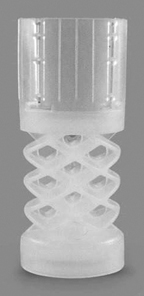 A related concern centers around plastic wads. The one-piece wad, a combination of over-powder card, a cushion to buffer the shot, and a “cup” to protect it from damage when it’s fired, is probably the greatest contributor to the improved performance of modern shotgun shells. But these wads are projected out of the barrel with the shot charge, so mostly they’re never retrieved at all. They too will remain in the environment forever. Old shotshells not only used degradable paper hulls, but fiber or cardboard over-powder and cushioning wads. These, too, of course, were ejected with the shot, but in time they disintegrated with exposure to the elements.
A related concern centers around plastic wads. The one-piece wad, a combination of over-powder card, a cushion to buffer the shot, and a “cup” to protect it from damage when it’s fired, is probably the greatest contributor to the improved performance of modern shotgun shells. But these wads are projected out of the barrel with the shot charge, so mostly they’re never retrieved at all. They too will remain in the environment forever. Old shotshells not only used degradable paper hulls, but fiber or cardboard over-powder and cushioning wads. These, too, of course, were ejected with the shot, but in time they disintegrated with exposure to the elements.
Paper hulls in fact never went totally out of production. Federal has made paper shells for many years for the target shooters. In Europe paper shells are still in production on a modest scale: Ely and Cheddite are two brands from the UK and France respectively. Even in European countries with a strong “green” ethos plastic shells predominate because of their distinctly better durability, patterning, and water-resistance. There is some evidence that with the rise of the environmental movement, paper hulls are making something of a comeback.
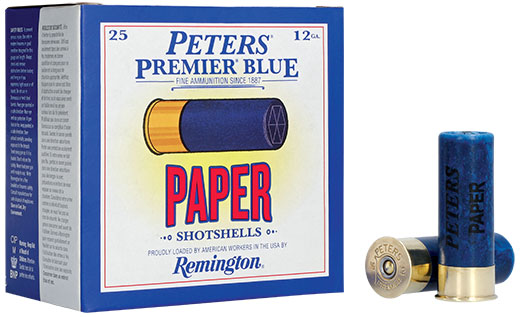
“Peters” is an old and honored name in the shotgun world. The more-or-less resurrected-from-bankruptcy Remington recently brought out the “Peters Blue” line of paper-hulled shells, with a strong hint of nostalgia in the advertising and labeling. Peters Blue seems so far to be a limited run, but if it’s a commercial success Big Green may continue to make them. I’m told by someone who knows that the reason these shells are blue (not green or red, more typical of 12 gauge ammunition) is that Vista Outdoors, which owns both Remington and Federal, ran out of red paper but could get blue. Rather than shut down Federal’s paper-shell production line they re-branded the product as “Peters Blue,” put it in a retro box, and marketed it that way.
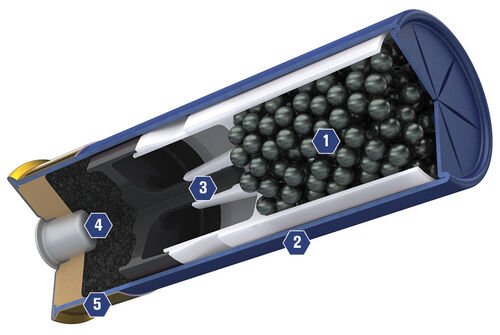
While the making of new paper hulls is a good thing for those concerned about environmental impacts, unfortunately even the new generation of paper shells employs plastic wads, not the older fiber types. In the cutaway image of the "Peters Blue" above, #3 is the plastic wad it uses. While no doubt some of this ammunition will in time be used on small game birds, it’s principally marketed to shooters in the shotgun sports—trap, skeet, and sporting clays—to whom uniform patterning is highly important. Therefore use of the superior plastic wads is understandable; and at least theoretically on target ranges most (but of course not all) the wads can be recovered.
At this point in any “either/or” essay about guns or hunting, I’m supposed to say, “Make your own choice,” and essentially not come to a real conclusion. That’s something I find immensely frustrating and it may be the reason I write for myself, not gun magazines. So I’ll tell you my choice, if choice I have: paper, for the reasons cited above.
I have a lot of plastic shells and I use them regularly but I doubt if they give me any advantage over the equally numerous paper ones I have. My wingshooting isn’t great, but I shot my first pheasant with a paper shell loaded for Montgomery Ward’s sometime around the Korean War. I’ve used paper shells many times since. Some time ago a friend gifted me a whole lot of paper-hulled 16 gauge shells (Try finding those today! Hen’s teeth are more common.) These are genuine antiques, some of them dating from well before World War Two. Nevertheless I have no doubt they’re as good today as when they were made, and plan to use them on my next bird shoot.
The admitted advantages of better patterns and longer range are pretty much irrelevant to me. There isn’t much upland game around here except squirrels, which are hunted with a shotgun as if it were a rifle. At 30 yards or less a paper shell with fiber wads and no shot cup works just fine. On the rare occasions when I go to a local shooting preserve for pheasant I just keep the range as short as I can. Would I do better with plastic? Probably not.
| OPENING PAGE|
|SEASON LOGS |
| HUNTING | GUNS | DOGS |
| FISHING & BOATING | TRIP REPORTS | MISCELLANEOUS ESSAYS |
| CONTRIBUTIONS FROM OTHER WRITERS|
| RECIPES |POLITICS |